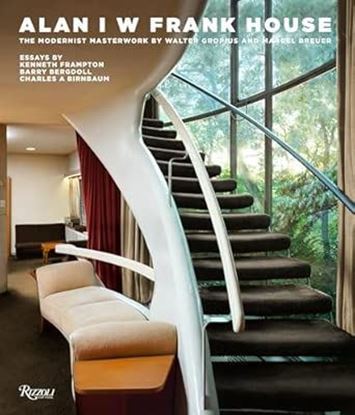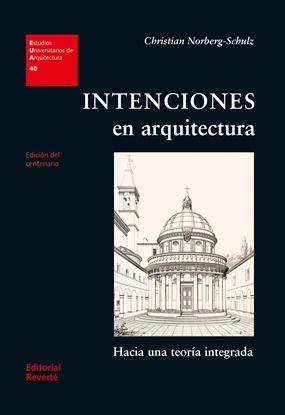

ALAN I W FRANK HOUSE: THE MODERNIST M.
The first book to feature this modernist masterpiece, one of Walter Gropius and Marcel Breuer's most important residential commissions.
Offering a rare opportunity to explore the largest and most luxurious house designed by Walter Gropius, founder of the Bauhaus, and Marcel Breuer, leading architect and furniture designer of the twentieth century, this beautifully designed volume celebrates the Alan I W Frank House in Pittsburgh, Pennsylvania.
Built in 1939-40, the house embodies the Bauhaus "total work of art" philosophy, with Gropius and Breuer having designed every aspect of the building and its site. Illustrations including new and archival images and the architects' plans and sketches highlight an exquisite balance of proportions and colors. Accompanying essays place this house firmly within the American modernist canon just as the Bauhaus celebrates its one-hundreth anniversary in 2019.
4,500
3,600
INTENCIONES EN ARQUITECTURA. HACIA UNA
Este libro apareció originalmente en inglés, fruto de la tesis doctoral del autor. La primera versión española se publicó en 1979 y se reimprimió en 1988. Desde entonces el libro ha estado descatalogado. Esta nueva edición, totalmente revisada y remaquetada con las figuras junto al texto, se publica para celebrar el centenario del nacimiento de Christian Norberg-Schulz.
Los arquitectos siempre se han mostrado bastante reacios a desarrollar una base teórica en su campo, sobre todo a causa del prejuicio de que la teoría acaba con la facultad creadora. En este estudio se intentará demostrar que esa visión es errónea.
El libro se centra principalmente en los aspectos simbólico y lingüístico, y su propósito es desarrollar una teoría integrada de la arquitectura. Para ello se indaga en la descripción y en las intenciones: la descripción, en la medida en que la arquitectura es una ciencia; las intenciones (tanto las del usuario como las del arquitecto), en la medida en que la arquitectura es un arte.
La estructura del libro es seguramente una de las construcciones intelectuales más impresionantes que haya elaborado nunca un arquitecto. Los fundamentos en los que se basa incluyen la psicología de la Gestalt, el mecanismo de la percepción, la teoría de la información, la filosofía analítica (en particular el análisis lingüístico) y la teoría general de los signos y los símbolos. Todos esos conocimientos tienen su lugar y su propósito, ninguno se emplea para lograr un efecto puramente decorativo. Y todos esos enfoques, aparentemente divergentes, se articulan en un plan estrictamente organizado para proponer una teoría de aplicación general, una teoría que abarca los aspectos funcionales, formales y técnicos que, combinados mediante relaciones semánticas, están siempre presentes en la obra de arquitectura, entendida como una totalidad.
1,950
1,560
VIVIENNE W. HISTORIA DETRAS DE LA MODA
Esta es la historia de una de las diseñadoras más icónicas del mundo, Vivienne Westwood, la revolucionaria de la moda.
Punk, precursora, rebelde y transgresora, llevó una vida fascinante. A través de una impresionante lista de logros, desde ser coronada como la «diseñadora de diseñadores» hasta liderar el activismo climático, es fácil entender cómo Westwood inspiró a generaciones de diseñadores de todo el mundo.
Los momentos de pasarela de Vivienne Westwood que han pasado a la historia, cómo ese vestido de novia llegó a aparecer en Sex and the City y cómo un collar de perlas se volvió viral en TikTok; desde sus colaboraciones más notables y los momentos clave de protesta hasta el último desfile y colección antes de su fallecimiento en 2022.
995
796
PEQUEÑO LIBRO DE ADIDAS
Descubra la legendaria historia de Adidas, la marca de las tres bandas inconfundibles que han conquistado el mundo.
En esta guía ilustrada, Josh Sims se adentra en la apasionante historia de una de las marcas más icónicas en la actualidad, desde sus orígenes en un pequeño pueblo de Alemania hasta convertirse en símbolo de calidad, rendimiento e innovación.
A través de los diseños más icónicos de la marca, las innovaciones que transformaron el sector y su influencia en la cultura pop, este libro representa una lectura esencial para los amantes de las últimas tendencias y de las sneakers.
1,200
960
PEQUEÑO LIBRO DE NIKE
Descubra la legendaria historia de Nike, que con su extraordinario diseño y el inconfundible Swoosh ha conquistado el mundo y se ha convertido en una especie de culto.
En esta guía ilustrada, Josh Sims analiza el ascenso de la compañía de equipamiento deportivo más grande del mundo, desde sus inicios humildes en Oregón hasta convertirse en un imperio global de la industria de la moda.
A través de los diseños más icónicos de la marca, las innovaciones que transformaron el sector y su influencia en la cultura pop, este libro representa una lectura esencial para los amantes de las últimas tendencias y de las sneakers.
1,200
960
TIFFANY & CO. HISTORIA DETRAS DE LA MODA
Todo el mundo conoce las cajitas azules de Tiffany & Co., pero esta es la fascinante historia real que hay detrás del éxito de la marca de joyería más famosa del planeta.
Descubra cómo el valiente emprendedor Charles Lewis Tiffany, recién llegado a la ciudad de Nueva York en 1837, consiguió convertirse en el «Rey de los diamantes».
La historia de grandes ganancias y pérdidas, del descubrimiento de gemas inéditas y genios del diseño, y de la creación de algunas de las joyas más emblemáticas de nuestro tiempo, entre las que se incluye el clásico anillo de compromiso Tiffany.
995
796













